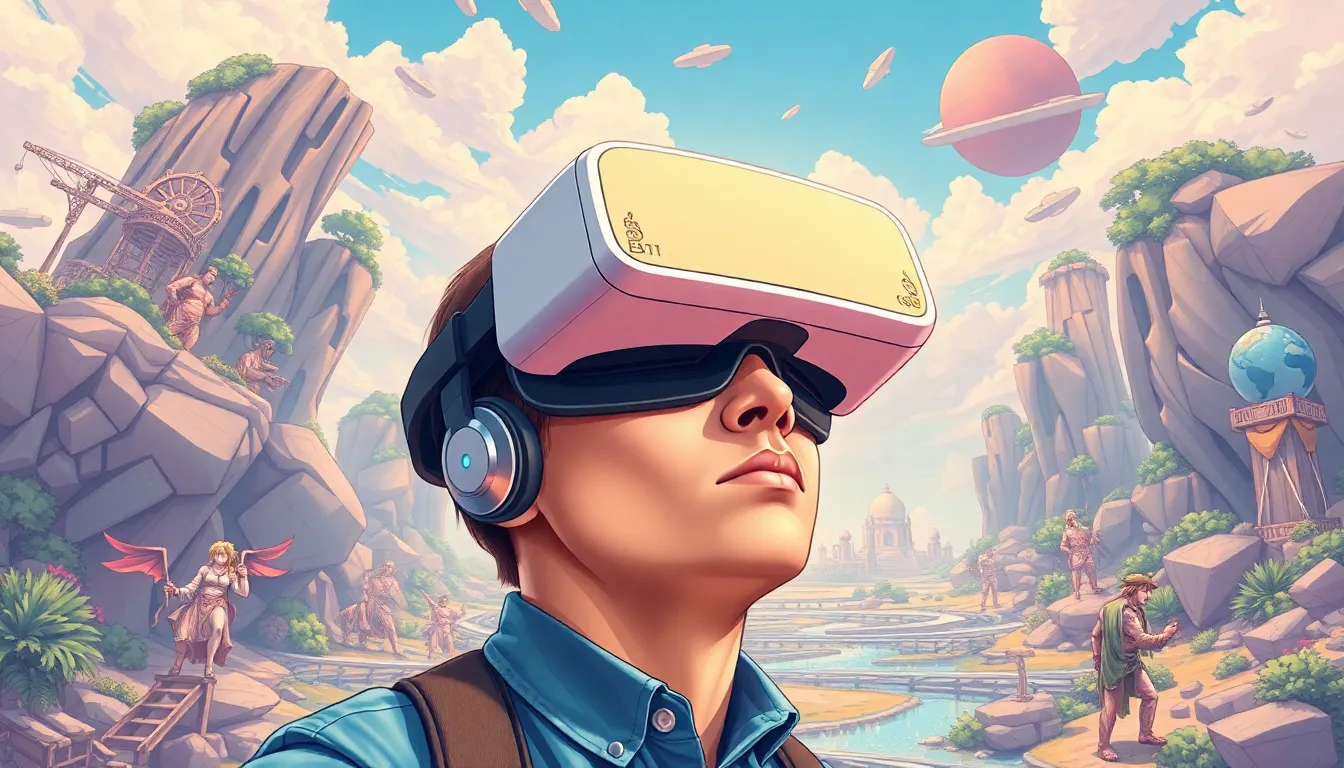Table of Contents
ToggleImagine stepping into a world where you’re not just a spectator but the hero of your own story. Welcome to the realm of VR storytelling, where reality takes a backseat and imagination drives the narrative. This isn’t just about watching a movie; it’s about living it. With virtual reality, every twist and turn becomes a thrilling adventure, and you might even find yourself dodging dragons or solving mysteries in your living room.
What Is VR Storytelling?
VR storytelling immerses users in narrative experiences, allowing them to actively engage with stories. Instead of being passive spectators, individuals step into the narrative, becoming part of the action. This medium utilizes advanced technology to create three-dimensional environments, enhancing emotional connections to the storyline.
Audiences interact with characters and settings through headsets and controllers. The experience feels personal and immediate. Players navigate through various scenarios, making choices that influence the story’s outcome. Such interactivity establishes a deeper emotional investment compared to traditional storytelling methods.
Notable examples of VR storytelling include experiences like “The Invisible Hours” and “Wolves in the Walls.” These experiences showcase the unique aspects of VR environments. Users explore different story paths, confronting challenges and solving puzzles. Beyond entertainment, VR storytelling finds applications in education and therapy, offering safe spaces for exploration and learning.
In essence, VR storytelling reshapes narratives and invites users into vibrant worlds. Content creators leverage this technology to craft compelling stories that provoke thought and inspire action. By merging technology and creativity, VR storytelling redefines the boundaries of narrative expression.
The Evolution of VR Storytelling

The evolution of VR storytelling reveals significant shifts in narrative techniques and audience engagement. Early developments paved the way for immersive experiences, while technological advances enhanced the realism of virtual environments.
Early Developments
Pioneers in VR storytelling emerged in the 1990s, introducing interactive narratives through basic 3D graphics. Titles like “Virtuality” and “The 7th Guest” began integrating storytelling elements with gameplay. Early attempts often lacked full immersion, but they set the groundwork for future innovations. As interest grew, filmmakers started experimenting with VR, creating short films that combined narrative and technology. “The 360 Video” format gained traction, allowing users to explore surroundings, although stories remained linear. These initial efforts highlighted storytelling’s potential to engage viewers actively, laying the foundation for more complex virtual narratives.
Technological Advances
Technological advances transformed VR storytelling, enhancing user experiences and engagement. High-resolution displays provide clearer visuals, while spatial audio creates realistic soundscapes. Motion tracking technology allows users to move freely, making them feel truly present in the story. Platforms such as Oculus Rift and HTC Vive have significantly improved accessibility to VR experiences. Developers now utilize advanced software tools, enabling intricate world-building and character interactions. As AI integration grows, stories can adapt dynamically to users’ choices. These advances ensure that VR storytelling continues to evolve, providing richer narratives and deeper emotional connections.
Key Elements of VR Storytelling
Virtual reality storytelling relies on specific elements to create engaging experiences. These elements enhance narratives, making them compelling for users.
Immersion and Presence
Users experience immersion through detailed 3D environments and realistic soundscapes. This sensory engagement fosters feelings of presence, as if participants exist within the story. In a well-crafted VR narrative, backgrounds and characters appear lifelike, intensifying emotional connections. Technologies like high-resolution displays provide visuals that captivate audiences. Spatial audio enhances this effect, allowing sounds to change based on the user’s position. When content encompasses these elements, it cultivates an environment conducive to genuine emotional responses.
Interactivity and Agency
Interactivity plays a crucial role in VR storytelling, enabling users to make choices that influence narratives. Users often interact with characters and environments, directly impacting plot progression. Agency becomes significant as participants feel responsible for decisions made within the story. They can pick dialogue options or explore settings at their own pace. Such freedom enhances engagement, as users invest in outcomes. Options for multiple endings or evolving storylines further encourage replayability. Ultimately, this level of interaction deepens users’ connections to the narrative and their role within it.
Applications of VR Storytelling
VR storytelling offers diverse applications across various fields, enhancing user experiences significantly.
Entertainment and Gaming
Entertainment thrives through VR storytelling, creating captivating experiences for users. In gaming, titles often immerse players in intricate worlds, allowing them to act as protagonists. Popular games like “Beat Saber” capture players’ attention with engaging mechanics and visually stunning environments. These immersive experiences elevate traditional gameplay by providing interactive narratives. Players frequently enjoy branching paths and unique endings tailored to their choices. The emotional connection deepens when individuals actively shape their journeys, leading to replayability and sustained interest. Overall, the integration of storytelling enriches the gaming landscape and attracts a wide audience.
Education and Training
Education utilizes VR storytelling to enhance learning environments. Immersive simulations foster engaging experiences, helping learners connect with complex concepts. Students in history classes can virtually visit ancient civilizations or historical events, providing context beyond textbooks. Medical training often incorporates VR to simulate surgeries or patient interactions, allowing students to practice essential skills in a safe environment. Users frequently report improved retention and understanding through hands-on experiences. Furthermore, this immersive approach adapts to various educational levels, making it accessible for diverse learners. VR storytelling’s contributions to education and training highlight its potential to reshape traditional methods and create lasting impacts.
Challenges and Limitations
VR storytelling faces several challenges and limitations that can affect user experience and narrative engagement. One significant issue is the cost of VR equipment. High-quality headsets and accessories can be expensive, limiting access for some audiences. Individuals may also experience discomfort or motion sickness when using VR, as prolonged usage can lead to fatigue. Adapting content for different comfort levels becomes essential in this context.
Another limitation involves technical constraints. Hardware performance, such as frame rates and latency, greatly influences immersion. Slow response times can detract from the feeling of presence within the narrative. Content development further complicates matters; creating compelling VR experiences requires specialized skills, which may not be readily available in every production team.
Narrative complexity serves as another hurdle. Traditional storytelling often relies on linear structures, whereas VR encourages branching paths and interactivity. Balancing story depth with user agency presents a challenge for creators aiming to keep users engaged. Navigating the intricacies of choice architecture and pacing becomes necessary to maintain a coherent narrative flow.
User familiarity with VR technology remains a concern too. Not everyone has experience with immersive environments, leading to a learning curve that may hinder full engagement. Providing tutorials or guidance can help bridge this gap, but it still requires additional resources and planning.
Lastly, ethical considerations arise in VR storytelling. Handling sensitive topics requires mindfulness and respect to avoid misrepresentation or triggering experiences for users. Upholding ethical standards in content creation becomes crucial for fostering inclusive and positive experiences within virtual reality storytelling.
Future Trends in VR Storytelling
Advancements in technology will shape the future of VR storytelling in significant ways. For instance, the integration of artificial intelligence could lead to fully adaptive narratives, allowing stories to evolve based on individual user actions and preferences. Developers envision characters becoming more responsive and lifelike, enhancing emotional connections between users and stories.
Collaboration across industries will also redefine VR experiences. Partnerships between filmmakers, game developers, and educators will create multifaceted narratives that blend entertainment with educational purposes. This cross-disciplinary approach may lead to immersive learning experiences, engaging users in ways previously unimagined.
User-generated content is gaining traction within the VR storytelling landscape. Enabling audiences to craft their narratives fosters community engagement and increases the volume of available stories, broadening the VR creative space. Platforms that support user contributions will likely flourish, creating a diverse range of experiences.
Social interaction within virtual environments is on the rise. The implementation of multiplayer VR storytelling allows individuals to explore narratives collectively, deepening social bonds and shared experiences. Users may collaborate to solve puzzles or navigate challenges, enhancing enjoyment and connection.
Accessibility remains a focal point for future developments. Efforts to reduce costs and expand availability will help VR storytelling reach wider audiences. By creating affordable headsets and user-friendly software, developers can ensure more people enjoy immersive narratives.
Sustainability is also becoming important. As environmental concerns grow, creators may prioritize eco-friendly practices in both hardware production and software development. This focus could contribute to a more responsible industry while still delivering captivating storytelling experiences.
Emerging trends in VR storytelling point towards more personalized, collaborative, and inclusive experiences while emphasizing accessibility and sustainability.
VR storytelling represents a groundbreaking shift in how narratives are experienced and engaged with. By immersing users in vibrant worlds and allowing them to influence outcomes, it creates deeper emotional connections. As technology continues to evolve, the potential for richer and more interactive experiences expands.
The applications of VR storytelling extend beyond entertainment into education and therapy, showcasing its versatility. While challenges remain, such as accessibility and technical limitations, the future looks promising. With ongoing advancements and a focus on inclusivity, VR storytelling is poised to redefine narrative engagement and create lasting impacts across various fields.







